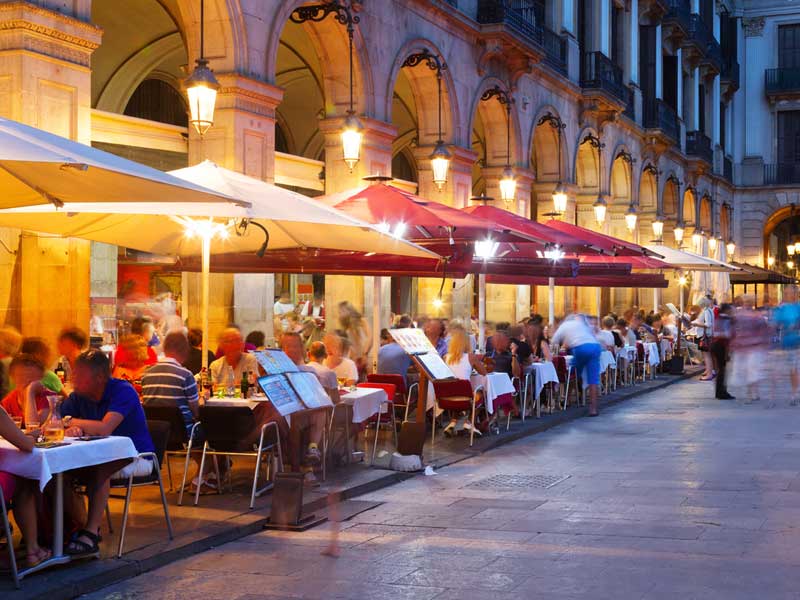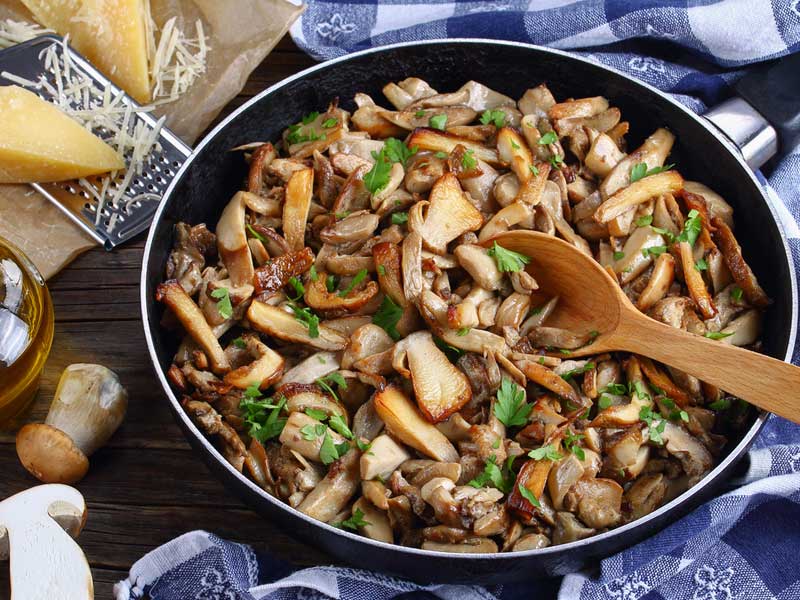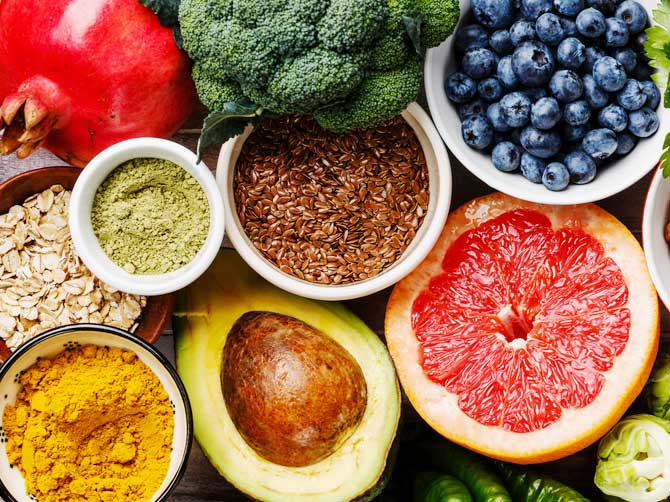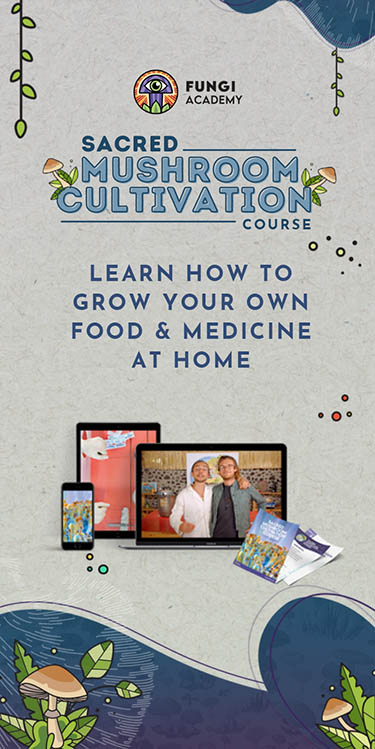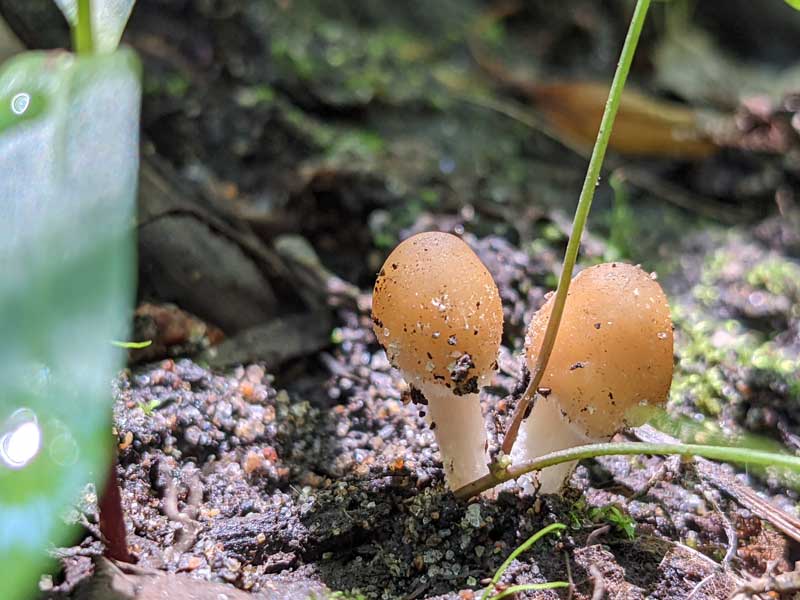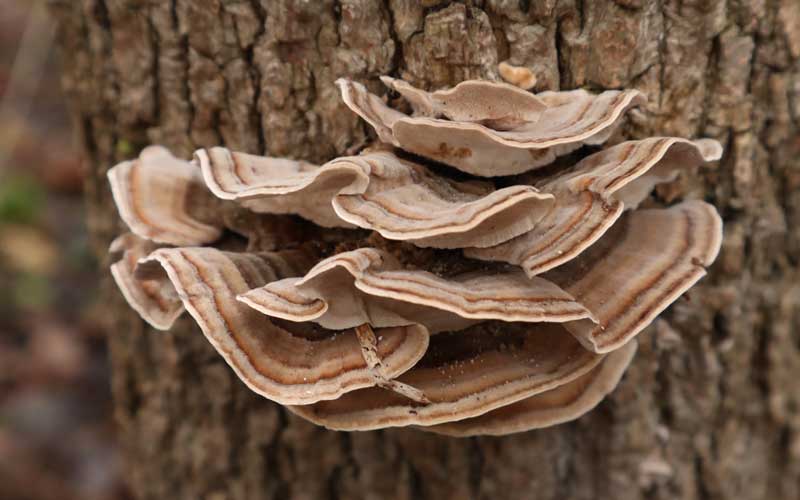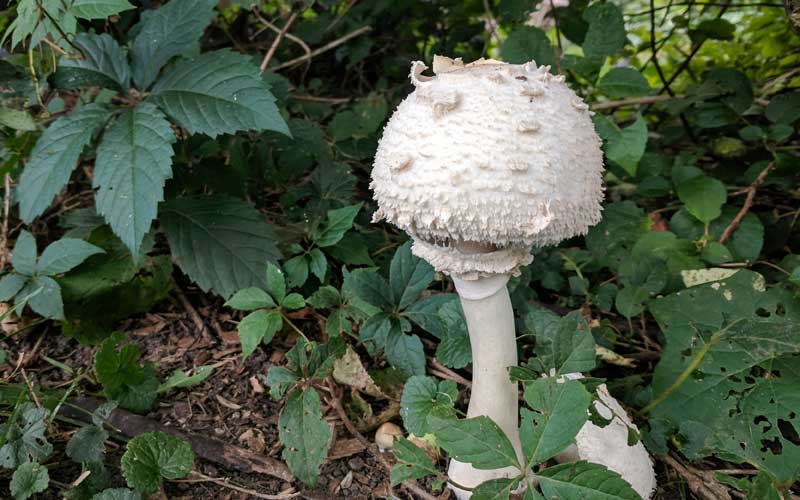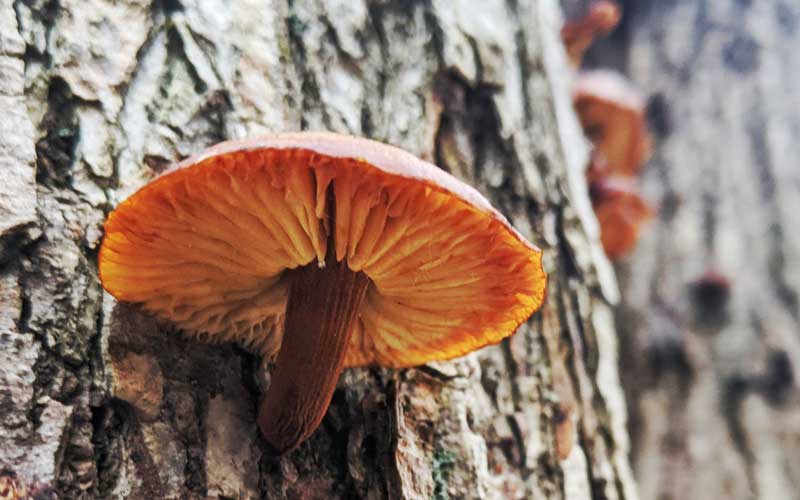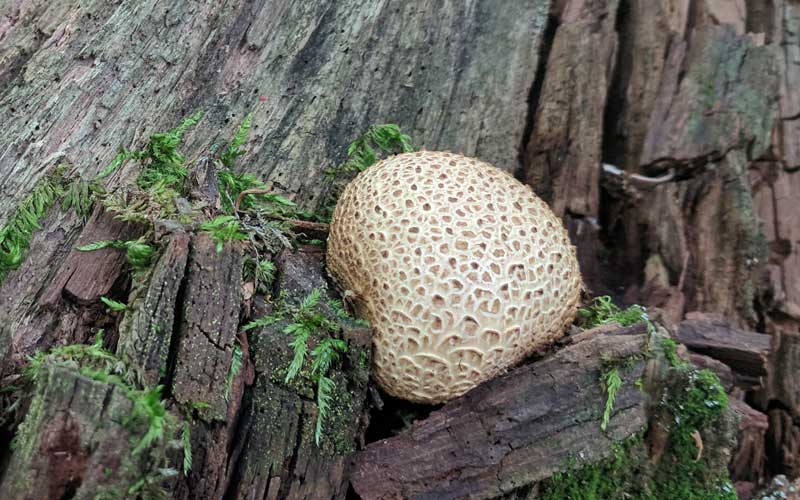- Home
- In the Kitchen
- Interviews With Chefs
- The Sioux Chef
The Sioux Chef – Sean Sherman - talks about wild foraged mushrooms and indigenous food systems.
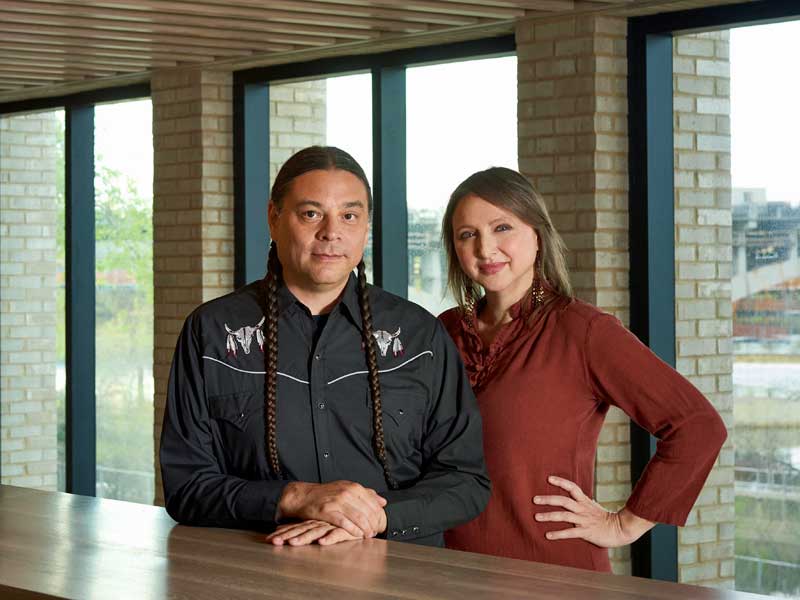 Sean Sherman & Dana Thompson at Owamni Restaurant in Minneapolis. Photo courtesy of The Sioux Chef, 2021.
Sean Sherman & Dana Thompson at Owamni Restaurant in Minneapolis. Photo courtesy of The Sioux Chef, 2021.What better North American chef to discuss cooking with mushrooms than The Sioux Chef – aka Sean Sherman (Oglala Lakota)?
We got the chance to interview Sean on how he incorporates mushrooms in the Native American cuisine featured at his exciting new restaurant, Owamni. He and his partner, Dana Thompson (Wahpeton-Sisseton and Mdewakanton Dakota), held the restaurant’s grand opening in Minneapolis in July 2021, earning rave reviews in Food and Wine, Axios, and on the Twin Cities foodie scene.
Owamni is the first Native American-owned restaurant of its kind – a mission-driven enterprise run entirely by indigenous team members, with representation from Anishinaabe, Northern Cheyenne, Dakota, Lakota, and Navajo tribes.
It offers a seasonal menu composed entirely of hyper-local indigenous foods that are healthy, naturally low glycemic, high protein, low salt, and low cholesterol. His unconventional cooking makes use of foraged foods native to South Dakota, Minnesota, and North America. Including wild fruits and berries, vegetables, grains, roots, seeds, nuts, bark, herbs, wild greens, and of course – mushrooms! As well as fresh fish, water fowl, and wild game, like bison, venison, elk, antelope, rabbit, and turkey.
But it’s what Sherman doesn’t use that sets his cuisine apart. You won’t find any European or foreign ingredients in his cooking – only foods endemic to North America. In an effort to decolonize cuisine and reintroduce native foods (and indigenous cooking methods) to his contemporary audience, Sherman uses no cane sugar, wheat flour, beef, chicken, pork, or dairy.
A leader in the Food Sovereignty movement, Sherman co-authored The Sioux Chef’s Indigenous Kitchen with Beth Dooley, and took the culinary scene by storm in 2017, receiving the James Beard Foundation Book Award for Best American Cookbook in 2018. And the James Beard American Leadership Award in 2019.
Since founding The Sioux Chef in 2014, Sherman’s revolutionary approach to indigenous cooking has been featured on NPR, PBS News Hour, Time Magazine, The Guardian, Saveur, Food & Wine, The Culinary Institute of America, TedX Sioux Falls, and the New York Times. So, we’re honored he carved out time in his busy schedule to speak with our team.
Let’s get started with the interview. To keep things simple, we’ll abbreviate IM for Incredible Mushrooms and SS for Sean Sherman.
IM: Before we jump into mushrooms, can you explain the Food Sovereignty Movement to our readers, and how it relates to eating wild-foraged foods like fungi?
SS: For me growing up on Pine Ridge Reservation, there's an obvious, gigantic need. We had one grocery store to service an area the size of Connecticut, for a pretty decent sized population, and really rural.
Because we grew up way out in the country, we had very little access to any foods, or healthy foods at least. The commodity food program was the mainstay in our cupboards. And it really hasn't changed much.
It actually feels like diets have gotten worse, and access to nutritional foods has gotten worse. The work we're doing explores indigenous food systems and their role in modern day society. And how important it is to indigenous communities.
We’re trying to bring back an education model to utilize ancestral food ways, which can really be impactful in their diets, and their health, in these rural communities. We really need a lot more cultural food producers, and a lot more support and education around growing and harvesting foods, training people to utilize their land, like the ancestors used to, and putting these (precolonial) foods on their tables.
Hopefully changing the way they prioritize where their food is coming from, what the community members are being fed. I think these are real solutions to how we work to address food security.
IM: In your cookbook, The Sioux Chef’s Indigenous Kitchen, you talk about how important dried mushrooms are to your pantry, and how wild mushrooms are one of your special kitchen ingredients – Can you explain why you love cooking with mushrooms?
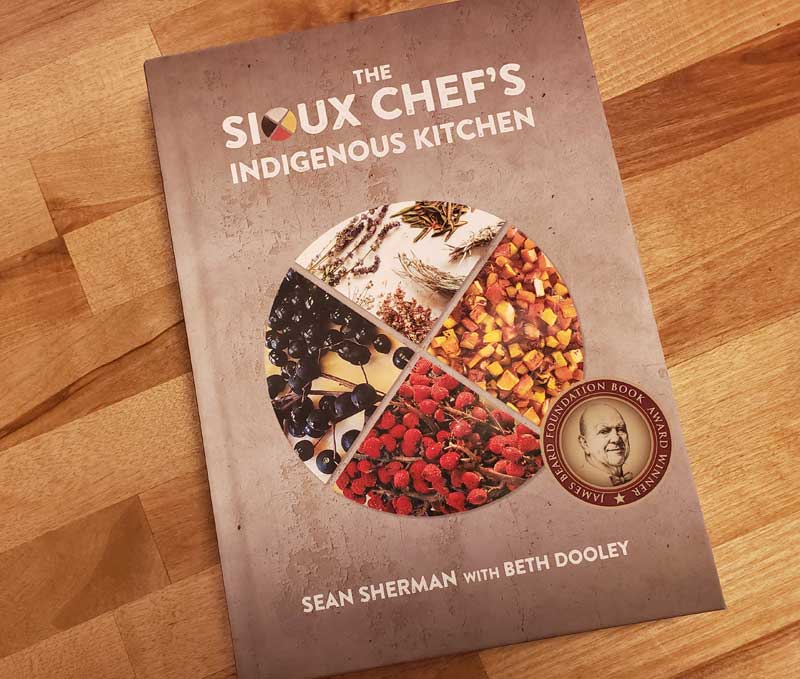 Sherman's award-winning cookbook, The Sioux Chef’s Indigenous Kitchen, published by University of Minnesota Press, 2017. Photo by NCHawkins
Sherman's award-winning cookbook, The Sioux Chef’s Indigenous Kitchen, published by University of Minnesota Press, 2017. Photo by NCHawkinsSS: They're fun! It's exciting when you're out in the woods and find a big fan of Chicken of the Woods, or some lobster mushrooms popping up, or morels in season, or whatever it might be.
It's really fun to be able to identify safely the mushroom varietals out there, and harvest them in prime condition, and bring them back to your kitchen.
IM: You like to harvest mushrooms yourself in nature?
SS: Yeah, I love being outdoors. And we try to make sure that the work ethic we have is getting our workers outdoors. It’s just great knowledge. And because of our nonprofit, we're able to pay for that education for some of our staff.
It’s part of the model of work we’re doing. We want them to become teachers, eventually. To have that knowledge so they can pass it down, to utilize local experts, and help train others.
I grew up out in the woods, because my mom was off the reservation when I was younger, and I spent a lot of time in the Black Hills (of South Dakota). And I worked for the Forest Service for a couple of years towards the end of high school, and learned a lot about the plants and mushrooms around that region. I've carried that knowledge with me through my career.
It's such great knowledge to have, to be able to connect with the world around you, to get outdoors, and disconnect from all of the internet zooms.
It's a time to learn the names of the plants, and how to identify mushrooms. It doesn't have to be instantaneous. You don't have to know them all right away. It can take years to absorb. And that's fine, as long as you take steps to see the world around you for what it is, which is so good.
IM: What are your favorite mushroom varieties to cook with, and where do you source them?
SS: It depends on where we're at. In Montana, I lived in the Red Lodge area, right on the border of the Beartooth mountains and the plains.
I was running this kitchen at a ranch, and I would teach the cowboys how to identify puff balls, because there would be giant ones out there, especially along the tree lines. They would go out on horseback every day, and come back with huge basketball-size ones. So (using) things like that are really fun.
But here in Minnesota, we have so many types, and there are so many great producers growing great varietals for us. We get a lot of oysters, and lobster mushrooms, and lion's mane. We’re able to get those on a commercial level, so we can share those with guests.
IM: How do you prepare and use dried mushrooms in your pantry?
SS: With the work we’re doing, we dehydrate a lot. We're able to buy some mushrooms that are on their way out, and we can dehydrate those for future use.
We’re smoking and drying and grinding them into powder; we prepare a smoked mushroom powder that’s awfully versatile. Just having fun with ingredients and stocking a pantry that reflects what’s around you in nature.
IM: Can you explain how mushrooms would have been used in precolonial cuisine, and why they remain an important foraged food for Native Americans today?
SS: Indigenous people have the privilege of having thousands of generations before them, to give them knowledge and education on how to utilize our environment… Not only animals and birds, and fish and insects, but all the plants and trees and roots and fungus that were out there.
After generations of understanding, there was a high level of ethnobotanical knowledge of what to do with all these pieces. Obviously, preparation of food is an easy one, because it usually comes down to dehydration, or smoking. But it’s really about harvesting and preserving. And understanding that food is medicine. Because people had to eat for health. And they had to eat preventatively. If they felt any sickness coming on, there would be foods available to serve that were combined with pharmacy.
Having that knowledge base of what to eat, how to eat, and when to eat. Also, how to harvest and when to harvest. If you look at pan-indigenous perspectives across the globe, you can find so much knowledge of all indigenous peoples utilizing their landscapes.
IM: Let’s talk about corn smut as a delicacy - also known as corn fungus, and called huitlachoche in Central America.
SS: They're super fun when they’re fresh, because you can slice them up really easily. I’ve dehydrated a lot of them, which keep for a long time. We find them all the time in Mexican markets.
The huitlacoche, they’re just a little sweet, with a little bit of that mushroom flavor. And a little bit of that corn flavor. And they’re inky black, which creates really cool sauces. It's almost like cooking with squid ink. We have a huitlacoche hot sauce that we make for the restaurant too.
IM: Congratulations again on your new restaurant! How are mushrooms featured on your menu at Owamni?
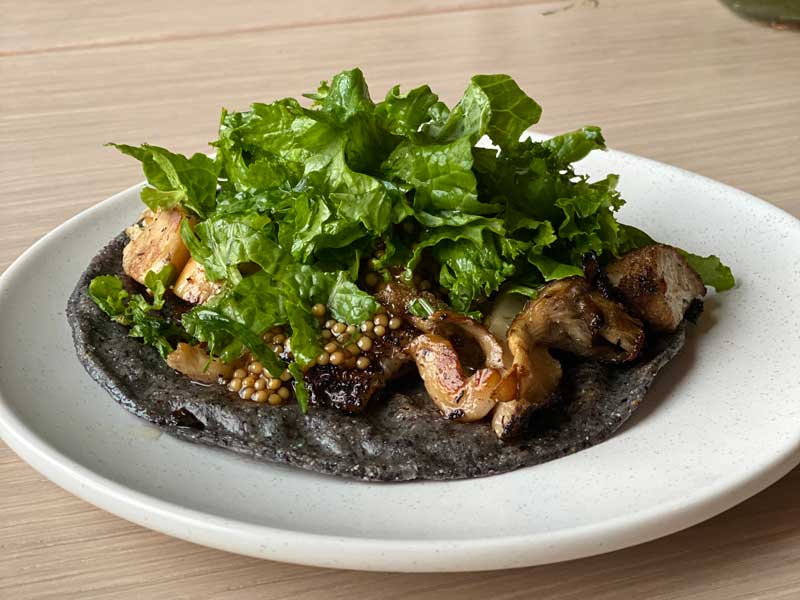 Mushroom Taco at Owamni, made with grilled forest mushrooms, pickled mustard seed & mustard greens, on a nixtamalized heirloom blue corn tortilla. Photo by Dana Thompson.
Mushroom Taco at Owamni, made with grilled forest mushrooms, pickled mustard seed & mustard greens, on a nixtamalized heirloom blue corn tortilla. Photo by Dana Thompson.SS: We have them in a few different things. It’s a menu that’s designed to be flexible and move with the seasons, to bring in products from local farms. And we prioritize purchasing from indigenous producers.
We try to produce food that tastes like where we are (Minnesota), or reflect a region with an indigenous perspective.
We work closely with our nonprofit kitchen, the Indigenous Food Lab, who are processing things like heirloom Native American corn tortillas, so we can make sandwiches using them. We have some smoked grilled mushrooms as a taco offering on one plate. And a native grain bowl with wild rice, quinoa, and mushrooms. They’re on some salads, and I spin the huitlacoche sauce, the corn fungus, too.
IM: Where can folks learn more about the food sovereignty movement and how to cook with healthy foraged foods, like mushrooms?
SS: There’s some great places that people can follow on social media. And there’s our nonprofit, which is North American Traditional Indigenous Food Systems (NATIFS). Through NATIFS, we have our nonprofit kitchen, called Indigenous Food Lab, which is a center for education, development, and research.
We want to further our own education, and create a safe haven so we can be true stewards of this knowledge moving forward, and so other people will have access to it.
Our goal is to work directly with tribal communities and help them develop their own indigenous culinary food programming. So they can offer healthy indigenous food to their communities, and develop more community-based gardens, and permaculture designs. And having professional kitchens built to process all that food. We’re hoping to help them develop menus and recipes relevant to their culture, their language, and region.
We’re in Minneapolis at the moment, but we can see indigenous food maps all over the place, even Seattle, Bay Area, Albuquerque, Denver, Boston, Chicago – preserving indigenous knowledge everywhere. We’re in dire danger of losing this important knowledge. How to live closely with our regions, with our plants… And from a non-colonial perspective, looking at the environment as a way to keep our communities healthy and happy.
And you don’t have to be indigenous to enjoy this knowledge base. To understand the value of indigenous peoples on a global scale. How we can work towards living better as humans, more closely with our environments, healthier, less processed foods, and not treating our land as something disposable. But really connecting with it, and helping it become healthy.
Note: This interview was edited for length and clarity.
Sean was kind enough to share with us his recipe for Hunter's Stew with Mushrooms.
Learn more about Sean Sherman and his work.
Sherman’s cookbook, The Sioux Chef’s Indigenous Kitchen, is available on Amazon.
Related Topics:
Interviews with international chefs who love to cook with mushrooms.
A series of interviews with chefs from around the world, all of whom love to create amazing dishes with mushrooms. The interviews...
Original mushroom recipes shared by mushroom lovers from around the world
These mushroom recipes include home-cooked favorites, plus exotic dishes from famous chefs who love to cook with mushrooms. The recipes...
Are mushrooms a superfood? Yes! Even if most people don’t know it.
Superfood lists overlook mushrooms, despite their health benefits. Find out why mushrooms should be on the superfood list. Read the full article...
